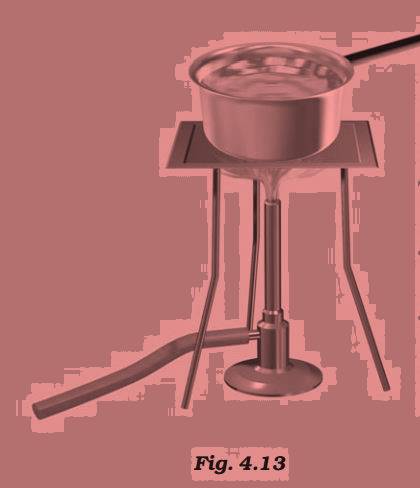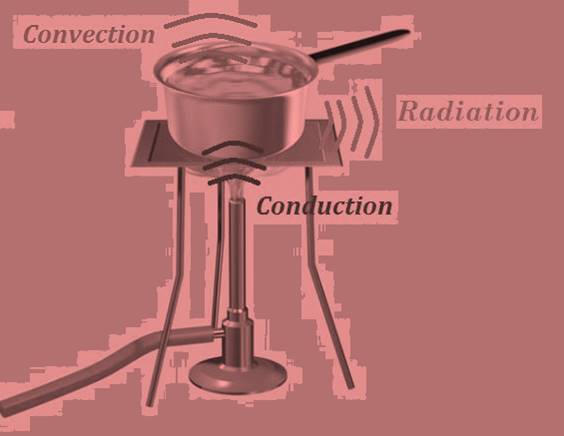Science
(www.olympiadsuccess.com)
Chapter 4: Heat
Class: VII
NCERT Questions
Question 1
State similarities and differences between the laboratory thermometer and the clinical thermometer.
Answer 1
Similarities:
Working principle of both the thermometer is same.
Both are used to measure temperature.
Both have a thick walled glass tube enclosing a fine uniform bore capillary tube. Mercury is used in both thermometers to measure temperature.
Both have Celsius and Fahrenheit markings.
Differences:
Laboratory thermometer is used to measure temperature of different objects in factories and laboratory where as clinical thermometer is used to measure the temperature of human beings only.
Generally, laboratory thermometer has temperature range from −10℃ to 110℃ where as clinical thermometer has temperature range from 35℃ to 42℃.
Usually laboratory thermometer does not have any constriction where as clinical thermometer has the small constriction near the mercury bulb.
Laboratory thermometer has to be kept upright while taking the reading where as clinical thermometer can be tilted while taking reading.
Question 2
Give two examples each of conductors and insulators of heat.
Answer 2
Conductors: Copper, aluminum and iron. Insulators: Wood, water and air.
Question 3
Fill in the blanks:
(a) The hotness of an object is determined by its __________.
(b) Temperature of boiling water cannot be measured by a _____________ thermometer.
(c) Temperature is measured in degree ______________.
(d) No medium is required for transfer of heat by the process of __________.
(e) A cold steel spoon is dipped in a cup of hot milk. It transfers heat to its other end by the process of ______________.
(f) Clothes of ______________ colours absorb heat better than clothes of light colours.
Answer 3
(a) The hotness of an object is determined by its temperature. (b) Temperature of boiling water cannot be measured by a clinical thermometer. (c) Temperature is measured in degree Celsius. (d) No medium is required for transfer of heat by the process of radiation. (e) A cold steel spoon is dipped in a cup of hot milk. It transfers heat to its other end by the process of conduction. (f) Clothes of dark colours absorb heat better than clothes of light colours.
Question 4
Match the following:
(i) Land breeze blows during (a) summer
(ii) Sea breeze blows during (b) winter
(iii) Dark coloured clothes are preferred during (c) day
(iv) Light coloured clothes are preferred during (d) night
Answer 4
(i) Land breeze blows during (d) night
(ii) Sea breeze blows during (c) day
(iii) Dark coloured clothes are preferred during (b) winter
(iv) Light coloured clothes are preferred during (a) summer
Question 5
Discuss why wearing more layers of clothing during winter keeps us warmer than wearing just one thick piece of clothing.
Answer 5
The air gets trapped between two layers of warm clothes. Air acts as insulator of heat. This layer prevents our body heat to escape in the surroundings. More layers of thin clothes will allow more air to get trapped and as a result we will not feel cold. So wearing more layers of clothing during winter keeps us warmer than wearing just one thick piece of clothing.
Question 6

Look at Fig. 4.13. Mark where the heat is being transferred by conduction, by convection and by radiation.
Answer 6

Question 7
In places of hot climate it is advised that the outer walls of houses be painted white. Explain.
Answer 7
In places of hot climate it is advised that the outer walls of houses be painted white because white colour reflects most of the heat that falls on it or we can say it absorbs less amount of heat. Therefore, the temperature inside the house does not increase very much.
Question 8
One litre of water at 30°C is mixed with one litre of water at 50°C. The temperature of the mixture will be (a) 80°C (b) more than 50°C but less than 80°C (c) 20°C (d) between 30°C and 50°C
Answer 8
(d) between 30°C and 50°C
Question 9
An iron ball at 40°C is dropped in a mug containing water at 40°C. The heat will (a) flow from iron ball to water. (b) not flow from iron ball to water or from water to iron ball. (c) flow from water to iron ball. (d) increase the temperature of both.
Answer 9
(b) not flow from iron ball to water or from water to iron ball.
Question 10
A wooden spoon is dipped in a cup of ice cream. Its other end (a) becomes cold by the process of conduction. (b) becomes cold by the process of convection. (c) becomes cold by the process of radiation. (d) does not become cold.
Answer 10
(d) does not become cold.
Question 11
Stainless steel pans are usually provided with copper bottoms. The reason for this could be that (a) copper bottom makes the pan more durable. (b) such pans appear colourful. (c) copper is a better conductor of heat than the stainless steel. (d) copper is easier to clean than the stainless steel.
Answer 11
(c) copper is a better conductor of heat than the stainless steel.
Yearlong program for Olympiads preparation & to build necessary skills for future.
Explore More
Time to mark your calendar with the upcoming Olympiads exam schedule.
Explore More
Take your Olympiad preparation to next-level by taking LIVE Classes.
Explore More
Assess your performance by taking topic-wise and full length mock tests.
Explore More
Online tuitions for international compeitions like SASMO, SEAMO, etc for Grades 1-11.
Explore More